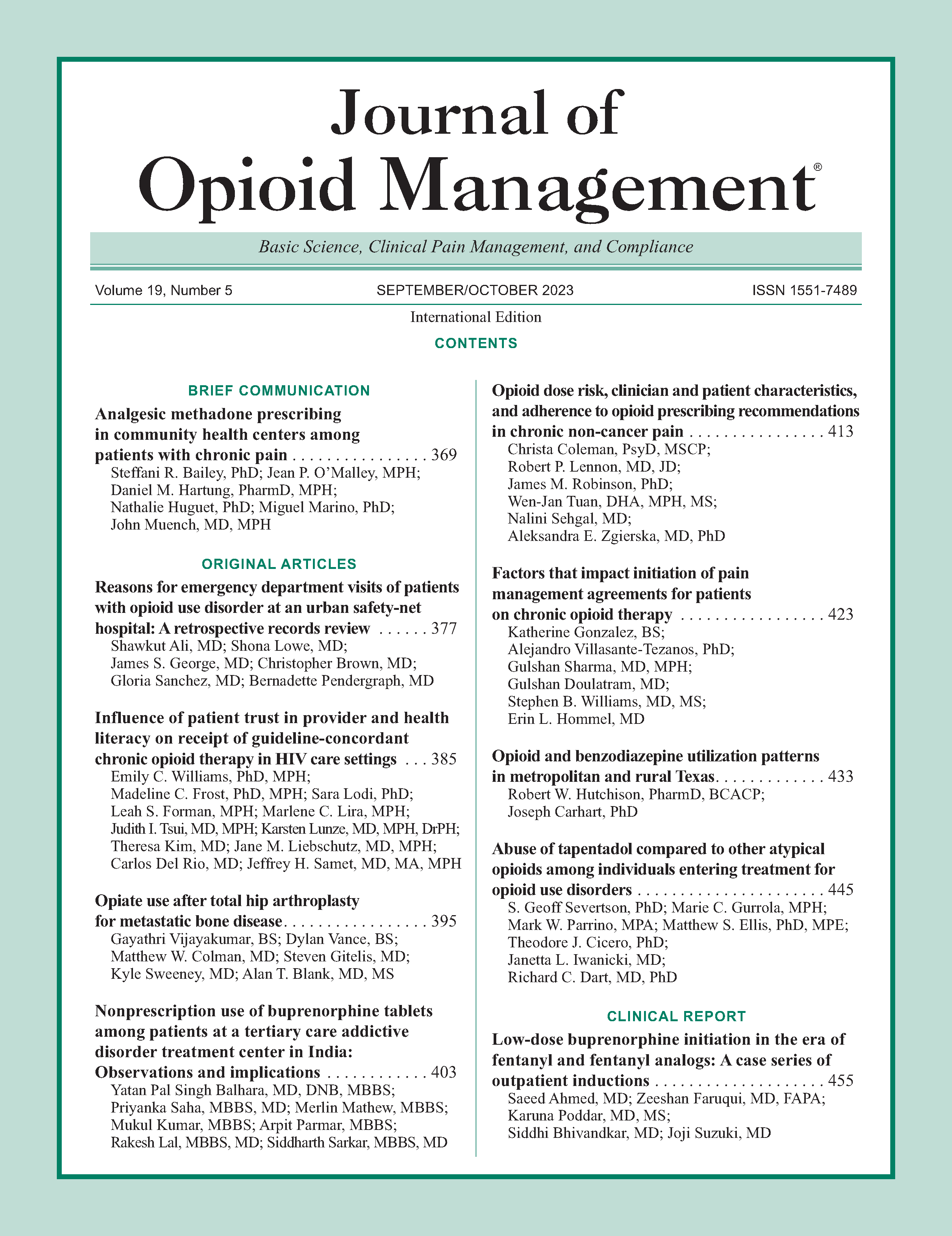Abuse of tapentadol compared to other atypical opioids among individuals entering treatment for opioid use disorders
DOI:
https://doi.org/10.5055/jom.0818Keywords:
opioids, abuse, tapentadol, atypical opioidsAbstract
Objective: Tapentadol is an atypical opioid analgesic thought to have dual mechanisms of action: μ-receptor agonism and inhibition of norepinephrine reuptake. Unlike other atypical opioids, tapentadol is a schedule II-controlled substance. We compared the prevalence of abuse (use to get high) of tapentadol to other atypical opioids used to treat pain (buprenorphine and tramadol).
Design: An observational, serial cross-sectional study.
Setting: Individuals enrolling in treatment programs for opioid use disorder in 2019. Each completed a self-administered, paper questionnaire assessing prescription drug abuse and illegal drug use within 1 week of enrollment.
Main outcome measures: Indication of past month abuse of tapentadol or comparator drugs on a self-administered questionnaire.
Results: There were 6,987 respondents. Unadjusted and utilization-adjusted logistic regression models were used to compare odds of endorsement of tapentadol to tramadol and buprenorphine products indicated for the management of pain. Unadjusted abuse prevalence was 0.20 percent for total tapentadol (0.03 percent for NUCYNTA® and 0.06 percent for NUCYNTA ER). Relative to total tapentadol, the odds of abuse of buprenorphine for pain was 2.9 times greater (95 percent CI: 1.6 to 5.3, p < 0.001), and for tramadol, 43.1 times greater (95 percent CI: 25.3 to 73.3, p < 0.001). Adjusting for prescriptions dispensed, differences in odds of abuse were not statistically significant (odds ratio (OR) = 1.6, 95 percent CI: 0.9 to 3.0, p = 0.108 for buprenorphine for pain and OR = 0.7, 95 percent CI: 0.4 to 1.2, p = 0.209 for tramadol).
Conclusions: Tapentadol use to get high is less frequent than other atypical opioids. Findings suggest tapentadol is rarely the primary drug abused by an individual.
References
Multiple Cause of Death 1999-2019 on CDC WONDER Online Database, released in 2020: Data are from the multiple cause of death files, 1999-2019, as compiled from data provided by the 57 vital statistics jurisdictions through the Vital Statistics Cooperative Program. [Internet]. 2021.
Raffa RB, Elling C, Tzschentke TM: Does ‘strong analgesic’ equal ‘strong opioid’? Tapentadol and the concept of ‘microload’. Adv Ther. 2018; 35(10): 1471-1484. DOI: https://doi.org/10.1007/s12325-018-0778-x
Wiegand TJ, Le Lait MC, Bartelson BB, et al.: Analysis of the abuse and diversion of the buprenorphine transdermal delivery system. J Pain. 2016; 17(6): 745-752. DOI: https://doi.org/10.1016/j.jpain.2016.02.015
Vosburg SK, Severtson SG, Dart RC, et al.: Assessment of tapentadol API abuse liability with the researched abuse, diversion and addiction-related surveillance system. J Pain. 2018; 19(4): 439-453. DOI: https://doi.org/10.1016/j.jpain.2017.11.007
Dart RC, Cicero TJ, Surratt HL, et al.: Assessment of the abuse of tapentadol immediate release: The first 24 months. J Opioid Manag. 2012; 8(6): 395-402. DOI: https://doi.org/10.5055/jom.2012.0139
Dart RC, Surratt HL, Le Lait MC, et al.: Diversion and illicit sale of extended release tapentadol in the United States. Pain Med. 2016; 17(8): 1490-1496. DOI: https://doi.org/10.1093/pm/pnv032
Schneider MF, Bailey JE, Cicero TJ, et al.: Integrating nine prescription opioid analgesics and/or four signal detection systems to summarize statewide prescription drug abuse in the United States in 2007. Pharmacoepidem Drug Safe. 2009; 18(9): 778-790. DOI: https://doi.org/10.1002/pds.1780
Drug Enforcement Administration DoJ: Schedules of controlled substances: Placement of tapentadol into schedule II. Available at https://www.govinfo.gov/content/pkg/FR-2009-02-17/pdf/E9-3150.pdf. Accessed June 15, 2021.
Murphy DL, Lebin JA, Severtson SG, et al.: Comparative rates of mortality and serious adverse effects among commonly prescribed opioid analgesics. Drug Saf. 2018; 41(8): 787-795. DOI: https://doi.org/10.1007/s40264-018-0660-4
Vosburg SK, Beaumont J, Dailey-Govoni ST, et al.: Evaluation of abuse and route of administration of extended-release tapentadol among treatment-seeking individuals, as captured by the addiction severity index-multimedia version (ASI-MV). Pain Med. 2020; 21(9): 1891-1901. DOI: https://doi.org/10.1093/pm/pnz250
Butler SF, McNaughton EC, Black RA: Tapentadol abuse potential: A postmarketing evaluation using a sample of individuals evaluated for substance abuse treatment. Pain Med. 2015; 16(1): 119-130. DOI: 10.1111/pme.12524. DOI: https://doi.org/10.1111/pme.12524
Dart RC, Surratt HL, Cicero TJ, et al.: Trends in opioid analgesic abuse and mortality in the United States. N Engl J Med. 2015; 372(3): 241-248. DOI: 10.1056/NEJMsa1406143. DOI: https://doi.org/10.1056/NEJMsa1406143
Ellis MS, Cicero TJ, Dart RC, et al.: Understanding multi-pill ingestion of prescription opioids: Prevalence, characteristics, and motivation. Pharmacoepidemiol Drug Saf. 2019; 28(1): 117-121. DOI: https://doi.org/10.1002/pds.4687
Severtson SG, Schwarz J, Dasgupta N, et al.: Rates of abuse for opioids with low dispensing are overestimated due to careless response patterns on treatment center program surveys. 2018. RADARS® System Technical Report, 2018-Q3.
Meade AW, Craig SB: Identifying careless responses in survey data. Psychol Methods. 2012; 17(3): 437-455. DOI: https://doi.org/10.1037/a0028085
Severtson SG, Bau E, Iwanicki JL, et al.: Use of self-report data results in differential misclassification and results in biased estimates of differences between specific opioid analgesic products. 2020. RADARS® System Technical Report, 2020-Q2.
Dart RC: Monitoring risk: Post marketing surveillance and signal detection. Drug Alcohol Depend. 2009; 105(Suppl. 1): S26-S32. DOI: https://doi.org/10.1016/j.drugalcdep.2009.08.011
Secora AM, Dormitzer CM, Staffa JA, et al.: Measures to quantify the abuse of prescription opioids: A review of data sources and metrics. Pharmacoepidemiol Drug Saf. 2014; 23(12): 1227-1237. DOI: https://doi.org/10.1002/pds.3711
Published
How to Cite
Issue
Section
License
Copyright 2005-2025, Weston Medical Publishing, LLC and Journal of Opioid Management. All Rights Reserved.











